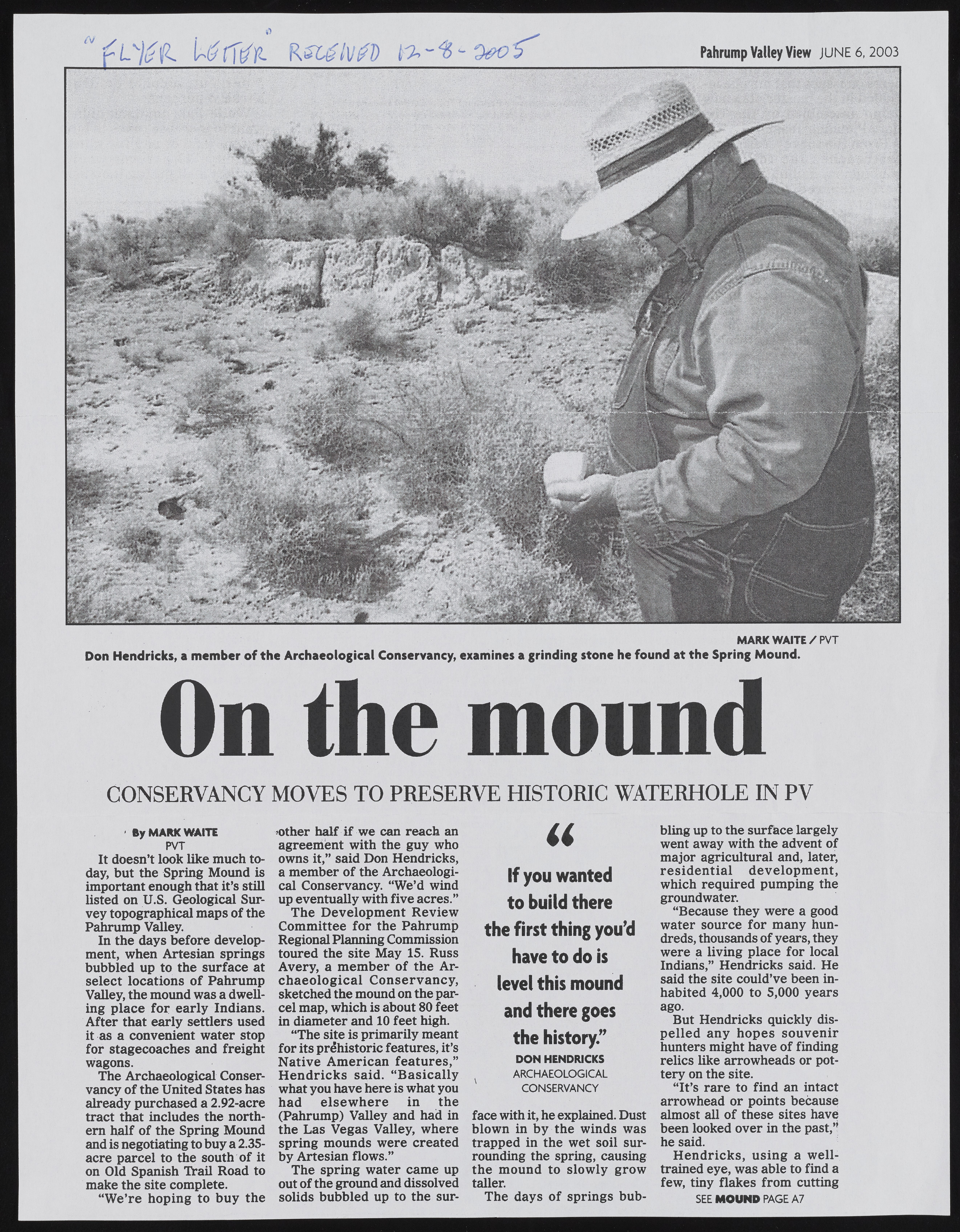Copyright & Fair-use Agreement
UNLV Special Collections provides copies of materials to facilitate private study, scholarship, or research. Material not in the public domain may be used according to fair use of copyrighted materials as defined by copyright law. Please cite us.
Please note that UNLV may not own the copyright to these materials and cannot provide permission to publish or distribute materials when UNLV is not the copyright holder. The user is solely responsible for determining the copyright status of materials and obtaining permission to use material from the copyright holder and for determining whether any permissions relating to any other rights are necessary for the intended use, and for obtaining all required permissions beyond that allowed by fair use.
Read more about our reproduction and use policy.
I agree.Information
Digital ID
Permalink
Details
More Info
Rights
Digital Provenance
Publisher
Transcription
Pahrump Valley View JUNE 6 ,2 0 0 3 MARK WAITE / PVT Don Hendricks, a member of the Archaeological Conservancy, examines a grinding stone he found at the Spring Mound* CONSERVANCY MOVES TO PRESERVE HISTORIC WATERHOLE IN PV By MARK WAITE PVT It doesn’t look like much today, but the Spring Mound is important enough that it’s still listed on U.S. Geological Survey topographical maps of the Pahrump Valley. In the days before development, when Artesian springs bubbled up to the surface at select locations of Pahrump Valley, the mound was a dwelling place for early Indians. After that early settlers used it as a convenient water stop for stagecoaches and freight wagons. The Archaeological Conservancy of the United States has already purchased a 2.92-acre tract that includes the northern half of the Spring Mound and is negotiating to buy a 2.35- acre parcel to the south of it on Old Spanish Trail Road to make the site complete. “We’re hoping to buy the ’Other half if we can reach an agreenient with the guy who owns it,” said Don Hendricks, a member of the Archaeological Conservancy. “We’d wind up eventually with five acres.” The Developm ent Review Committee for the Pahrump Regional Planning Commission toured the site May 15. Russ Avery, a member of the Arch aeological C onservancy, sketched the mound on the parcel map, which is about 80 feet in diameter and 10 feet high. “The site is primarily meant for its prehistoric features, it’s N ative American features,” H endricks said. “B asically what you have here is what you had elsew h ere in the (Pahrump) Valley and had in the Las Vegas Valley, where spring mounds were created by Artesian flows.” The spring water came up out of the ground and dissolved solids bubbled up to the sur- If you wanted to build there the first thing you’d have to do is level this mound and there goes the history.” DON HENDRICKS ARCHAEOLOGICAL CONSERVANCY face with it, he explained. Dust blown in by the winds was trapped in the wet soil surrounding the spring, causing the mound to slow ly grow taller. The days of springs bubbling up to the surface largely went away with the advent of major agricultural and, later, resid en tial developm ent, which required pumping the groundwater. “Because they were a good water source for many hundreds, thousands of years, they were a living place for local Indians,” Hendricks said. He said the site could’ve been inhabited 4,000 to 5,000 years ago. But Hendricks quickly dispelled any hopes souvenir hunters might have of finding relics like arrowheads or pottery on the site. “It’s rare to find an intact arrowhead or points because almost all of these sites have been looked over in the past,’* he said. H endricks, using a w ell-trained eye, was able to find a few, tiny flakes from cutting SEE MOUND PAGE A7

